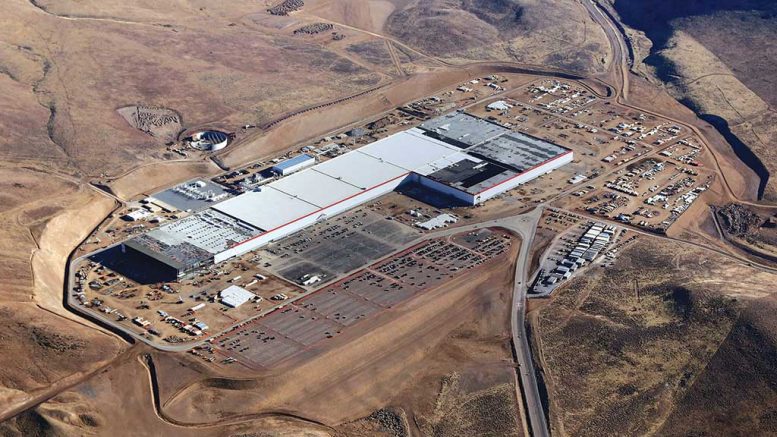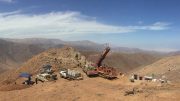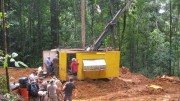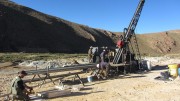Lithium is heating up, with the price globally on the rise following higher demand.
The U.S. Geological Survey (USGS) estimates lithium production last year increased 12% due to a spike in demand for lithium-ion batteries. That demand will likely stay strong as carmakers increase their production of electric vehicles. Tesla Motors intends to roll out 500,000 electric vehicles by the end of 2018. But the company has a tendency of overpromising.
Regardless, lithium producers are ramping up capacity to meet future demand, while other companies race to the finish line. This has caused an uptick in activity in South America’s lithium triangle, which hosts more than half of the world’s lithium reserves.
According to the USGS, output in Argentina alone jumped 60% in 2016, owing to a new brine operation and a leading Argentine producer bulking up its output. A producer in Chile also bumped its output 20%.
The USGS adds that despite available capacity, spot lithium prices last year rose 40% to 60% worldwide, excluding China, where prices jumped 300%, partly due to a temporary shortage of imported spodumene from Australia.
Major lithium producers Albemarle (NYSE: ALB), Sociedad Quimica y Minera de Chile (NYSE: SQM) and FMC (NYSE: FMC) registered share price gains of 53.5% in 2016. They are up another 21% year-to-date as of May 4, 2017.
Albemarle
North Carolina-headquartered specialty chemicals company Albemarle joined the coveted lithium triangle after taking over Rockwood Holdings in early 2015. It now has lithium operations in Chile, the U.S. and Australia.
In January 2017, Albemarle revised its lithium production rights with the Chilean Economic Development Agency (Corfo) to both extend the agreement and the company’s lithium production at its facility in Chile’s Salar de Atacama. With this agreement, Albemarle can produce over 80,000 tonnes a year of battery-grade lithium salts over the next 27 years at its expanding La Negra battery-grade manufacturing facilities.
Two months later, Albemarle reported plans to double lithium concentrate production at its 49%-held Greenbushes spodumene mine in Australia to more than 160,000 tonnes a year. Commissioning of the expansion should start in the second quarter of 2019.
In May, the company reported that its first-quarter net sales in 2017 jumped 10% to US$722 million from a year ago. Of this total, Albemarle’s lithium and advanced materials segment contributed net sales of US$284.4 million, up 31.5% from the earlier year.
The stock closed May 4 at US$108.71, up 24% year-to-date. Last year, Albemarle shares appreciated 56.2%.
SQM
Santiago-based SQM produces lithium and derivatives at its Salar del Carmen facilities, near Antofagasta, Chile.
It recorded revenues of US$515 million from its lithium segment in 2016, up 131% from 2015. The segment accounted for 55% of the company’s gross profit for the year.

Lithium Americas’ Cauchari-Olaroz lithium project in Argentina, where SQM is a joint-venture partner. Credit: Lithium Americas.
Last March, SQM signed a joint-venture agreement with Lithium Americas (TSX: LAC) to develop the Cauchari-Olaroz lithium project in Argentina, marking its first venture outside of Chile. The project has a total annual capacity of 50,000 tonnes of battery-grade lithium carbonate. The first stage, estimated to cost US$425 million, should produce 25,000 tonnes a year.
In 2017, SQM intends to invest US$100 million in Cauchari-Olaroz. Construction is set to begin this year, with production starting in 2019.
It also plans to increase its lithium hydroxide capacity this year from 6,000 tonnes to 13,500 tonnes a year, by increasing efficiencies and building a 7,000-tonne-plant.
Despite problems with Corfo over leases related to its brine operations in the Salar de Atacama, SQM shares increased nearly 58% over 2016 to US$28.54. It recently closed at US$33.30, up almost 16%.
FMC
FMC produces from Argentina’s Salar del Hombre Muerto. Its lithium segment reported first-quarter 2017 revenue of US$66 million, up 9% from the same period last year. Segment earnings rose 45% to US$22 million in the period.
FMC has increased its full-year lithium guidance by US$10 million at the midpoint versus its previous forecast. It expects full-year segment revenue of US$325 million to US$365 million, and full-year segment earnings of US$100 million to US$120 million.
This revised earnings forecast represents more than a 55% increase over 2016’s US$70 million. This increase is driven by the company’s hydroxide expansion and higher prices for its hydroxide products.
FMC estimates its annual hydroxide production capacity will increase from 10,000 tonnes to 18,000 tonnes by mid-year. It expects to expand to 30,000 tonnes a year in the next couple of years, depending on demand.
Last October, FMC signed a deal with Nemaska Lithium (TSX: NMX), which was amended in March 2017. Under the revised terms, the Quebec-focused junior will provide FMC 8,000 tonnes of lithium carbonate a year, starting in April 2019 instead of mid-2018. FMC also agreed to pay a lump sum of US$10 million to Nemaska by April 7, 2017.
For 2016, FMC shares rose nearly 47%. Year-to-date its shares are up 24% to US$70.73.






How are things coming along at OOrocobre?
John